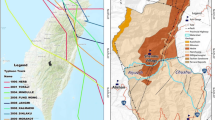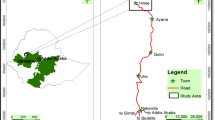Abstract
Xiaolin, a small village in southern Taiwan, was completely buried by a deep-seated landslide during the extreme rainfall of Typhoon Morakot in 2009, and 500 people were killed. This disaster caused great public concern. This study examines the rainfall-induced landslide characteristics in the area and their correlations with various susceptibility factors. We emphasize the importance of producing an accurate landslide inventory using visual interpretation and propose a new systematized set of subcategories of susceptibility factors, especially stream factors. We used satellite images, digital elevation models, and landslide inventories from before and after the disaster to perform spatial analysis using geographic information system (GIS) tools. Of the topographical factors considered, only slope aspect was important, and the landslides bore little relation to tectonic lines. The stream factors had the strongest influence on these landslides. Almost 100 % of the landslide area was related to various types of erosion caused by the stream network. Most of the large-scale landslides were induced by headward erosion, and all occurred on dip or oblique slopes. Thus, a combination of dip or oblique slope types and stream factors resulted in more landslides, which suggests that landslides are often induced by a combination of multiple factors.








Similar content being viewed by others
References
Avanzi GD, Giannecchini R, Puccinelli A (2004) The influence of the geological and geomorphological settings on shallow landslides. An example in a temperate climate environment: the June 19, 1996 event in northwestern Tuscany (Italy). Eng Geol 73:215–228
Alkhasawneh MS, Ngah UK, Tay LT, Isa NAM (2014) Determination of importance for comprehensive topographic factors on landslide hazard mapping using artificial neural network. Environmental Earth Sciences 72(3):787–799
Borghuis AM, Chang K, Lee HY (2007) Comparison between automated and manual mapping of typhoon-triggered landslides from SPOT-5 imagery. Int J Remote Sens 28(7–8):1843–1856
Broothaerts N, Kissi E, Poesen J, Van Rompaey A, Getahun K, Van Ranst E, Diels J (2012) Spatial patterns, causes and consequences of landslides in the Gilgel Gibe catchment, SW Ethiopia. Catena 97:127–136
Borgomeo E, Hebditch KV, Whittaker AC, Lonergan L (2014) Characterising the spatial distribution, frequency and geomorphic controls on landslide occurrence. Molise, Italy, Geomorphology 226:148–161
Chen CY, Huang WL (2013) Land use change and landslide characteristics analysis for community-based disaster mitigation. Environ Monit Assess 185(5):4125–4139
Chen SC, Chou HT, Chen SC, Wu CH, Lin BS (2014) Characteristics of rainfall-induced landslides in Miocene formations: a case study of the Shenmu watershed, Central Taiwan. Eng Geol 169:133–146
Chen CY (2015) Landslide and debris flow initiated characteristics after typhoon Morakot in Taiwan. Landslides. doi:10.1007/s10346-015-0654-6
Chue YS, Chen JW, Chen YR (2015) Rainfall-induced slope landslide potential and landslide distribution characteristics assessment. J Mar Sci Technol 23(5):705–716
Dai FC, Lee CF, Wang SJ (2003) Characterization of rainfall-induced landslides. Int J Remote Sens 24(23):4817–4834
Dominguez-Cuesta MJ, Jimenez-Sanchez M, Berrezueta E (2007) Landslides in the central coalfield (Cantabrian Mountains, NW Spain): geomorphological features, conditioning factors and methodological implications in susceptibility assessment. Geomorphology 89(3–4):358–369
Dahl MPJ, Mortensen LE, Jensen NH, Veihe A (2013) Magnitude–frequency characteristics and preparatory factors for spatial debris-slide distribution in the northern Faroe Islands. Geomorphology 188:3–11
Demir G, Aytekin M, Akgun A (2015) Landslide susceptibility mapping by frequency ratio and logistic regression methods: an example from Niksar–Resadiye (Tokat, Turkey). Arab J Geosci 8(3):1801–1812
Franks CAM (1999) Characteristics of some rainfall-induced landslides on natural slopes, Lantau Island, Hong Kong. Q J Eng Geol 32:247–259
Guzzetti F, Ardizzone F, Cardinali M, Galli M, Reichenbach P, Rossi M (2008) Distribution of landslides in the Upper Tiber River basin, central Italy. Geomorphology 96(1–2):105–122
Goswami R, Mitchell NC, Brocklehurst SH (2011) Distribution and causes of landslides in the eastern Peloritani of NE Sicily and western Aspromonte of SW Calabria, Italy. Geomorphology 132(3–4):111–122
Hovius N, Stark CP, Allen PA (1997) Sediment flux from a mountain belt derived by landslide mapping. Geology 25(3):231–234
Korup O (2005a) Geomorphic imprint of landslides on alpine river systems, southwest New Zealand. Earth Surf Process Landf 30(7):783–800
Korup O (2005b) Distribution of landslides in southwest New Zealand. Landslides 2(1):43–51
Kirschbaum DB, Adler R, Hong Y, Hill S, Lerner-Lam A (2010) A global landslide catalog for hazard applications: method, results, and limitations. Nat Hazards 52(3):561–575
Kim G, Won S, Kim D (2014) GIS based analysis of landslide effecting factors in the Pyeongchang area. Journal of the Korean Society of Surveying, Geodesy, Photogrammetry and Cartography 32(3):261–269
Kayastha P (2015) Landslide susceptibility mapping and factor effect analysis using frequency ratio in a catchment scale: a case study from Garuwa sub-basin. East Nepal Arabian Journal of Geosciences. doi:10.1007/s12517-015-1831-6
Lee CT (2009) Review and prospect on landslide and debris flow hazard analysis. Journal of the Taiwan Society of Public Works 5:1–29(in Chinese with English abstract)
Lee CT, Kang KH, Cheng CT, Liao CW (2000) Surface rupture and ground deformation associated with the Chi-Chi, Taiwan earthquake. Sino-Geotechnics 81:5–18(in Chinese with English abstract)
Lee CT, Huang CC, Lee JF, Pan KL, Lin ML, Dong JJ (2008a) Statistical approach to storm event-induced landslides susceptibility. Nat Hazards Earth Syst Sci 8(4):941–960
Lee CT, Huang CC, Lee JF, Pan KL, Lin ML, Dong JJ (2008b) Statistical approach to earthquake-induced landslide susceptibility. Eng Geol 100(1–2):43–58
Lin CW, Chang WS, Liu SH, Tsai TT, Lee SP, Tsang YC, Shieh CL, Tseng CM (2011) Landslides triggered by the 7 August 2009 typhoon Morakot in southern Taiwan. Eng Geol 123(1–2):3–12
Malamud BD, Turcotte DL, Reichenbach P, Guzzetti F, Reichenbach P (2004) Landslide inventories and their statistical properties. Earth Surf Process Landf 29(6):687–711
Msilimba GG, Holmes PJ (2010) Landslides in the Rumphi District of Northern Malawi: characteristics and mechanisms of generation. Nat Hazards 54(3):657–677
Martha TR, Kerle N, Jetten V, Van Westen CJ, Kumar KV (2010) Characterising spectral, spatial and morphometric properties of landslides for semi-automatic detection using object-oriented methods. Geomorphology 116(1–2):24–36
Mondini AC, Chang KT (2014) Combining spectral and geoenvironmental information for probabilistic event landslide mapping. Geomorphology 213:183–189
Mansour Z, Miloud B, Donzé F, Soraya R, Abderahmane H (2015) Morphometric analysis of landslides in the Ouarsenis area (west Algeria): implications for establishing a relationship between tectonic, geomorphologic, and hydraulic indexes. Arab J Geosci 8(9):6465–6482
Nichol J, Wong MS (2005) Satellite remote sensing for detailed landslide inventories using change detection and image fusion. Int J Remote Sens 26(9):1913–1926
Panikkar SV, Subramanyan V (1996) A geomorphic evaluation of the landslides around Dehradun and Mussoorie, Uttar Pradesh, India. Geomorphology 15(2):169–181
Rose RCD (2013) Slope control on the frequency distribution of shallow landslides and associated soil properties, North Island, New Zealand. Earth Surf Process Landf 38(4):356–371
Regmi NR, Giardino JR, Vitek JD (2014) Characteristics of landslides in western Colorado, USA. Landslides 11(4):589–603
Paudel PP, Omura H, Kubota T, Inoue T (2007) Spatio-temporal patterns of historical shallow landslides in a volcanic area, Mt. Aso, Japan. Geomorphology 88(1–2):21–33
Strahler AN (2010) Quantitative geomorphology of drainage basins and channel network. In: Handbook of Applied Hydrology. McGraw-Hill Book Company, USA, pp 4–39 ~ 4–76
Tsai F, Hwang JH, Chen LC, Lin TH (2010) Post-disaster assessment of landslides in southern Taiwan after 2009 typhoon Morakot using remote sensing and spatial analysis. Nat Hazards Earth Syst Sci 10(10):2179–2190
Vorpahl P, Elsenbeer H, Märker M, Schröder B (2012) How can statistical models help to determine driving factors of landslides? Ecol Model 239:27–39
Wu CH, Chen SC, Chou HT (2011) Geomorphologic characteristics of catastrophic landslides during typhoon Morakot in the Kaoping Watershed, Taiwan. Eng Geol 123(1–2):13–21
Weng MC, Wu MH, Ning SK, Jou YW (2011) Evaluating triggering and causative factors of landslides in Lawnon River Basin, Taiwan. Eng Geol 123(1–2):72–82
Wan S, Lei TC, Chou TY (2014) Optimized object-based image classification: development of landslide knowledge decision support system. Arab J Geosci 7(5):2059–2070
Yusof NM, Pradhan B, Shafri HZM, Jebur MN, Yusoff Z (2015) Spatial landslide hazard assessment along the Jelapang Corridor of the North-South Expressway in Malaysia using high resolution airborne LiDAR data. Arabian Journal of Geosciences. doi:10.1007/s12517-015-1937-x
Zhou CH, Lee CF, Li J, Xu ZW (2002) On the spatial relationship between landslides and causative factors on Lantau Island, Hong Kong. Geomorphology 43(3–4):197–207
Zhang S, Zhang LM, Glade T (2014) Characteristics of earthquake- and rain-induced landslides near the epicenter of Wenchuan earthquake. Eng Geol 175:58–73
Acknowledgments
The authors sincerely thank the Center for Space and Remote Sensing Research, National Central University, for providing the digital elevation models from before and after Typhoon Morakot, as well as other technical supports.
Author information
Authors and Affiliations
Corresponding author
Rights and permissions
About this article
Cite this article
Deng, Y.C., Tsai, F. & Hwang, J.H. Landslide characteristics in the area of Xiaolin Village during Morakot typhoon. Arab J Geosci 9, 332 (2016). https://doi.org/10.1007/s12517-016-2342-9
Received:
Accepted:
Published:
DOI: https://doi.org/10.1007/s12517-016-2342-9




